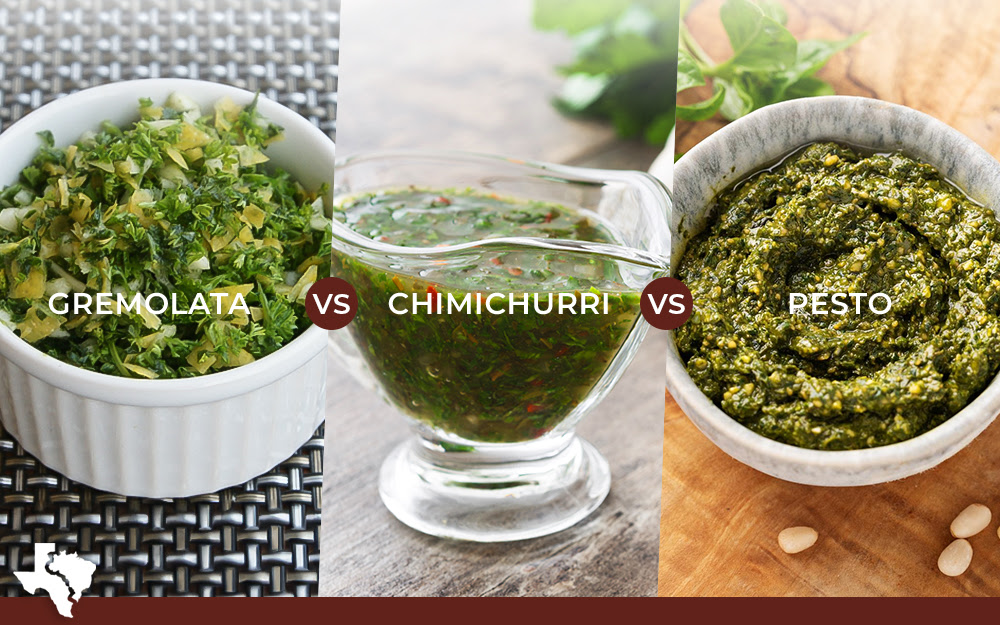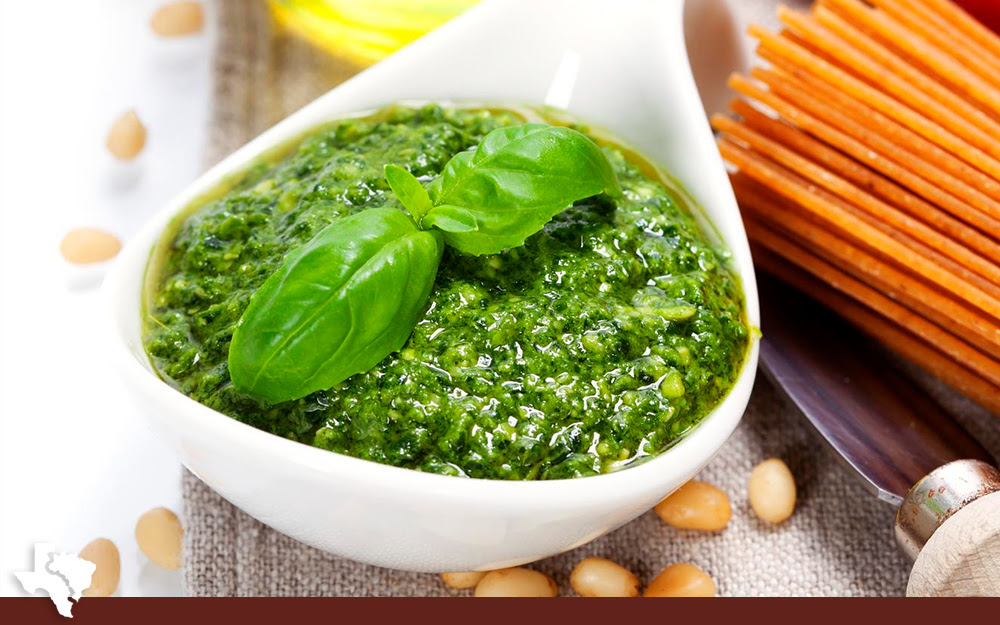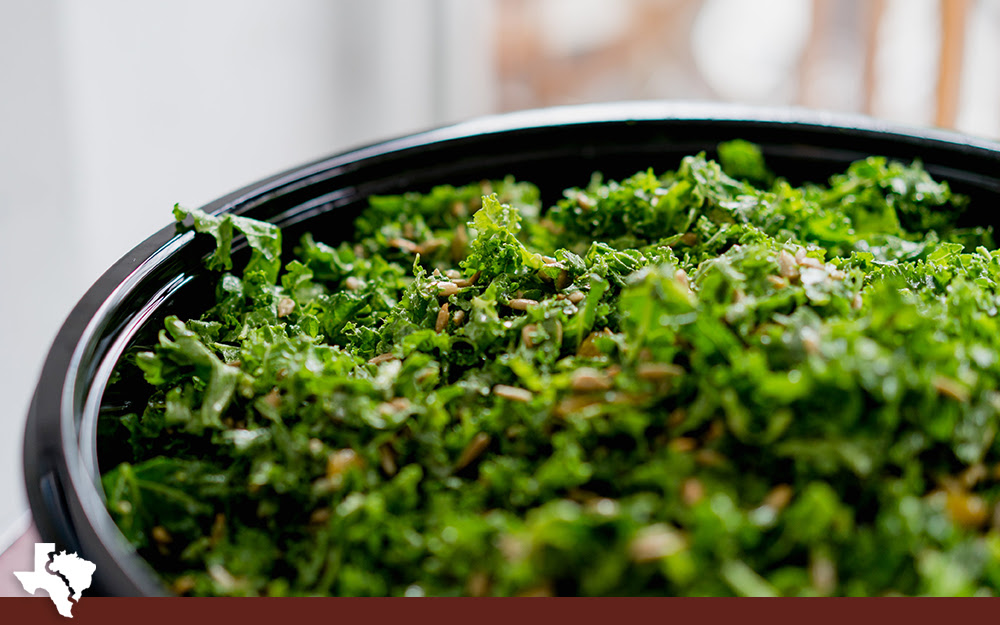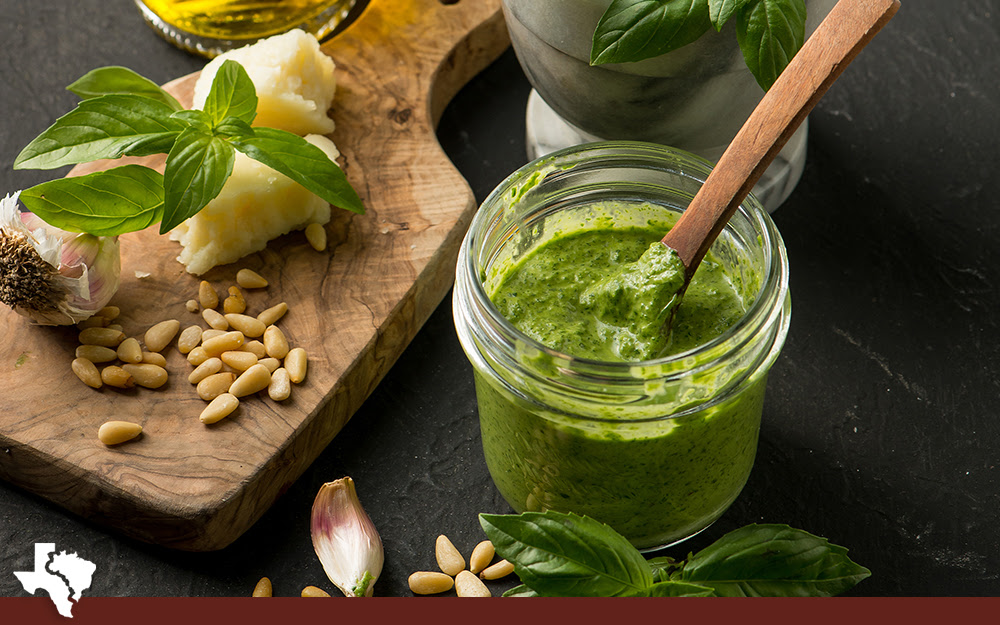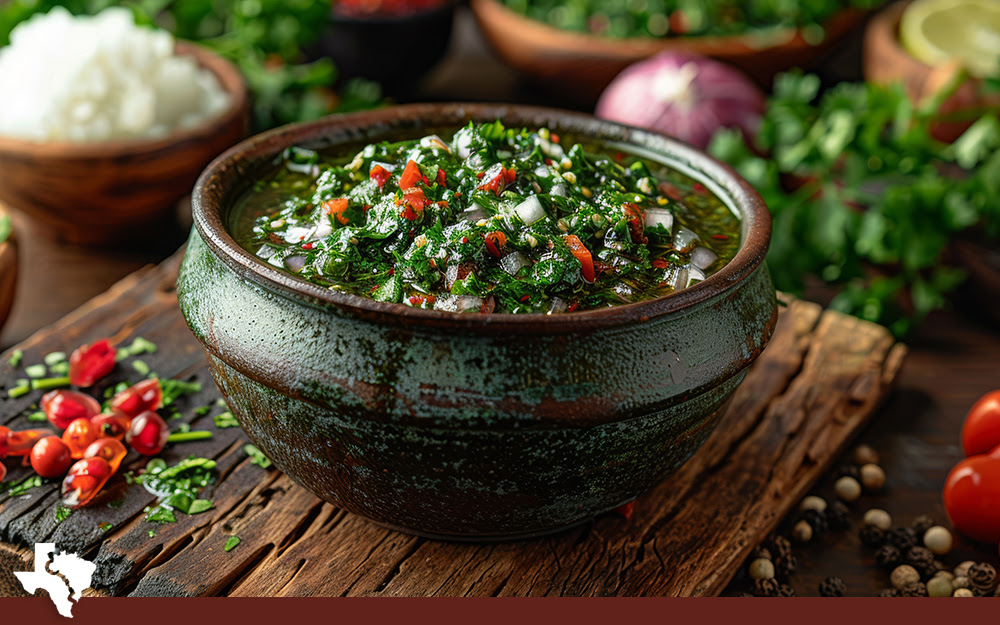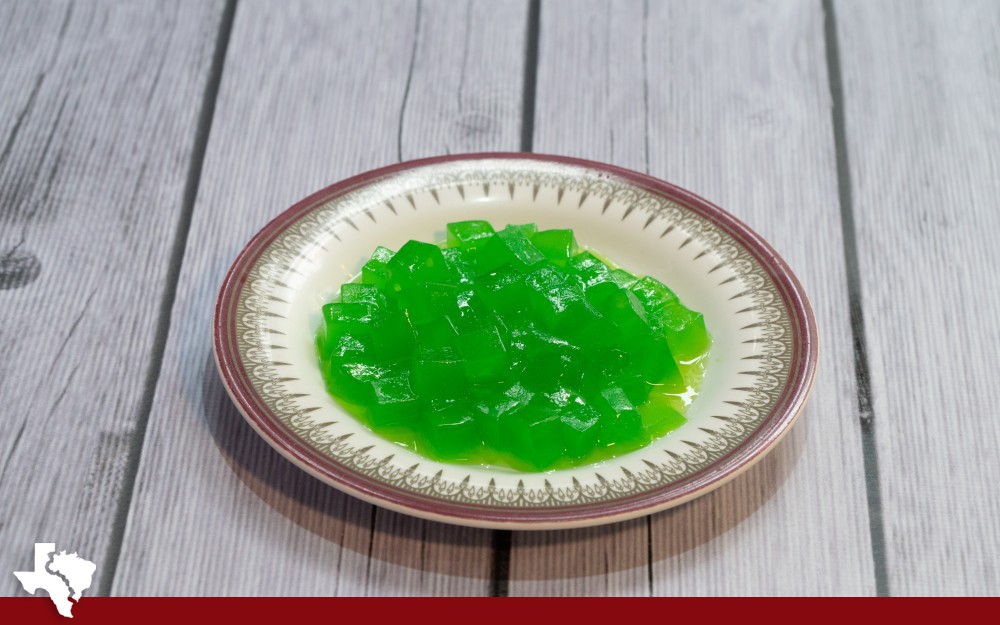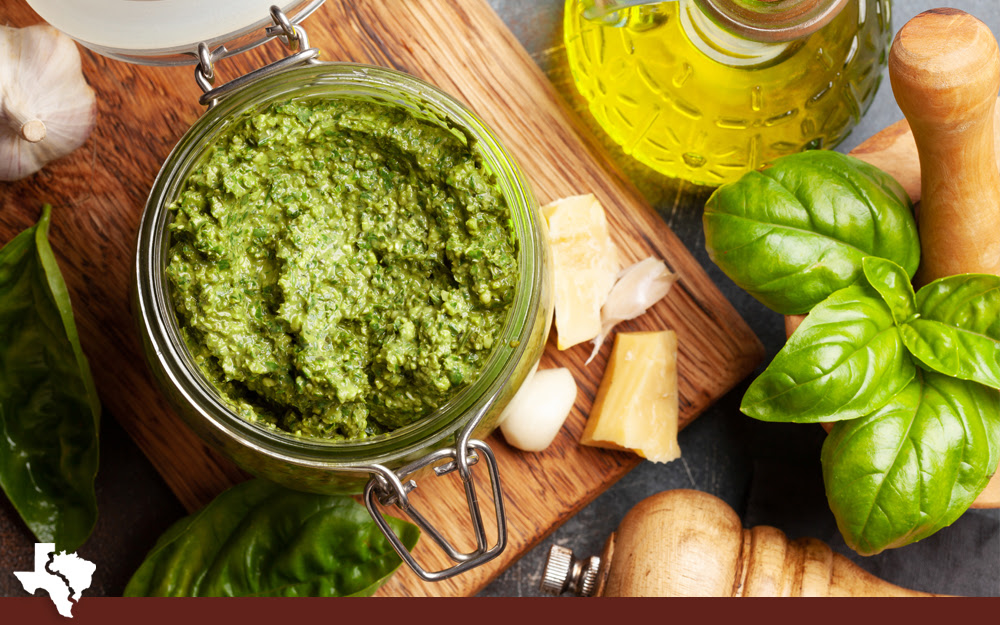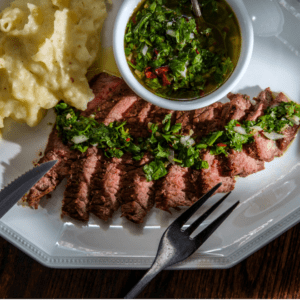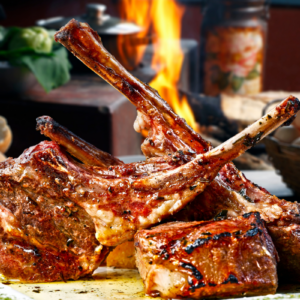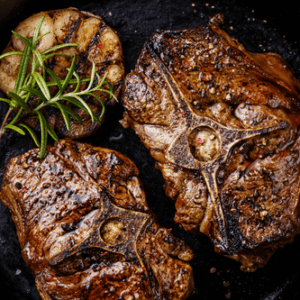Gremolata vs Chimichurri vs Pesto: What’s the Difference?
What’s that delicious green stuff in the salad area?
We get this question a lot, and the answer may surprise you. The simple answer is, usually, chimichurri, but there are actually a bunch of similar green sauces you can find in different restaurants and churrascarias around the world. Three of the best are chimichurri, pesto, and gremolata. But what are they, what are the differences between them, and which one goes best with your favorite cut of meat? Let’s dig in!
Table of Contents
What are Green Sauces and How Are They Used?
First, let’s talk about the broad category of green sauces. All three of the sauces we’ve mentioned here today are green sauces, and for obvious reasons; they’re all a bright, vibrant green!
Green sauces are all broadly similar, and they can be very customizable, so there are dozens of recipes for each of the three, some so different you’d think they’re something else entirely. But they all serve the same purpose: a bright, herbal garnish to a main dish.
That’s right; green sauces are there to augment another dish, usually a rich kind of meat. They’re usually herbal, sometimes with added flavors like lemon, garlic, vinegar, or chili pepper, to contrast to the deep flavors of a well-marbled meat, the smokey flavors of a grill, and the salt crusted on a good cut of steak.
Green sauces can be used as a garnish or a dip and are sometimes diluted down and used as a dressing or even a marinade. They’re super versatile, and moreover, they’re incredibly easy to make if you have the ingredients on hand. You don’t have to come all the way to Texas de Brazil to get a serving, though, of course, we’d be happy to have you.
With so many different options for green sauces, though, you have to wonder: what even are they all, how do you make them, and how are they best used? Fortunately, we’re here to help shed light on these nutritious, delicious sauces.
What is Gremolata?
Gremolata is a traditional green sauce used as an accompaniment to many dishes, but first and foremost, it is a particular kind of braised veal found in the northern areas of Italy Lombardy. Though the origins are pinned down, the ingredients are simple enough that you can be sure a similar sauce has been made many times wherever the ingredients are available. So, what are those ingredients?
A traditional gremolata green sauce is made out of three ingredients, so make sure if you’re making some yourself, you’re getting the best quality ingredients you can!
Ingredient 1: Parsley
A gremolata is a green sauce, and a green sauce needs an herb to give it that green, herbal vibrance. Parsley is the herb of choice for a gremolata. Easy, right? Just go grab a bunch from the local grocer and get to chopping.
But wait! There are actually several different kinds of parsley, and your choice of parsley can make a significant difference in the sauce. After all, it’s the star of the show!
First, you have Chinese parsley. Chinese parsley isn’t actually parsley at all, though it resembles the herb. You’re likely much more familiar with Chinese parsley under its other names: coriander and cilantro.
That’s right; coriander and cilantro are actually the same plant! Coriander is the name of the spice made from the dried seeds of the plant, while cilantro is the name of the leaves and stems of the fresh herb. Either way, while you could use cilantro/Chinese parsley in your gremolata, it’s certainly not what the people of Lombardy were using.
Second, you have English parsley. English parsley is commonly known as “curly parsley” because the leaves are crinkled and curled, and it has a thicker plant material. Unfortunately for green sauce lovers, English parsley doesn’t have much flavor at all, so it’s not ideal for a great gremolata. It makes a very pretty garnish, though!
Third, you have the real star of the show: Italian parsley. It’s probably no surprise that gremolata, the sauce made in Italy, uses Italian parsley as its base, right? Also known as flat-leaf parsley, this is the most flavorful and most commonly used as an ingredient.
Ingredient 2: Citrus Zest
The second ingredient is citrus zest. Most commonly today, this is lemon zest, which contains all of the aromatic and bright oils from the lemon peel without any of the bitterness from the pith or the overly sour juice of the lemon itself.
That said, a traditional gremolata may be made with other citrus peels or zests as well. Lime, orange, and even grapefruit were all commonly used.
Ingredient 3: Garlic
No gremolata is complete without garlic. Frankly, no meal is complete without garlic (with apologies to those of you who are allergic to alliums.) Gremolata is no different, and grated or chopped garlic is the core of the flavors.
Making a gremolata is super simple, too. All you need to do is get all three ingredients, chop them up, and mix them together. Unlike other green sauces, there’s no oil or vinegar to mix is all together; it relies just on the juices of the ingredients on their own. As such, it’s usually a thicker, chunkier sauce, and isn’t good as a marinade.
Many gremolata variations can be made using other ingredients as well. Some do use coriander, and others add herbs like mint and sage. Some put in more pungent flavors like horseradish or shallots, and some round out the flavors with ingredients like anchovies or pecorino romano cheese. The traditional gremolata, though, is much simpler.
What is Pesto?
The second green sauce – and the one most Americans are more familiar with – is pesto. Pesto is another traditional Italian green sauce, but it originated in Genoa. Two herb-forward green sauces emerging from the northern regions of Italy? What are the chances? Pretty good! Pesto likely originated as far back as the ancient Romans, whose “moretum” sauce was somewhat similar to a complex pesto recipe.
Like gremolata, a good pesto only has a few ingredients. However, unlike gremolata, a pesto is more of an actual sauce, and is more often crushed and blended into something mostly smooth, rounded out with oil, rather than just a chopped mixture of herbs and garlic.
What are the ingredients in pesto?
The traditional pesto is also herb-based. Hence, the green color and flavor, but the herb of choice is basil. Much like parsley, basil comes in multiple forms, but for obvious reasons, the Italian basil – also known as Genovese basil – is probably the most common. Sweet basil, Thai basil, and other basils can also be used. However, remember, if you’re going to use something like Osmin Purple basil, your green sauce won’t be green.
Garlic, of course, is the co-star in a good pesto. But, there are three other ingredients besides the herb and garlic.
First up is the olive oil. A good extra virgin olive oil is the tastiest, and the flavor really can come through to augment the herbal flavors of the pesto. You don’t need a lot of oil, just enough to make it a sauce; too much can make it harder to coat things like pasta with it!
The second up is pine nuts. Pine nuts are just what they sound like the edible seeds of a pine tree. That’s right, those pine cones are good for more than just arts and crafts around Christmas time! Toasted pine nuts are delicious and add a hearty substance to a good pesto.
The third ingredient is usually a parmesan cheese. Grated parmesan is itself fairly nutty with a hint of cheesy goodness, and it goes great, whether it’s on a parmesan-crusted chicken breast or worked into a delectable green sauce.
While pesto is most commonly seen as a sauce for pasta, it also goes great as a dip for all sorts of meats, as a marinade for many more, as part of a pesto salad, and pretty much anywhere you’d love the flavors of garlic and basil. You can also make pesto with a wide range of different variations, including using pecans or walnuts instead of pine nuts, adding in a dash of citrus, and much more.
What is Chimichurri?
On the surface, chimichurri seems a lot like the other two green sauces on this list. It’s a very herb-forward green sauce, after all. But that’s just about where the similarities end.
For one thing, chimichurri isn’t from Italy. It’s actually from pretty far away from Italy! Originally a part of Rio de la Plata cuisine, chimichurri made its way throughout South America and is a staple in Uruguay, Paraguay, and, of course, Brazil. These days, you’ll be hard-pressed to find anywhere in South and Latin America that doesn’t have chimichurri as an option.
Chimichurri is also made with a few different ingredients. First, though, the similarities.
Chimichurri is, of course, based on an herb. The primary herb is parsley, and you can bet that the traditional flat-leaf Italian parsley is the star here. However, most chimichurri also use other herbs, like oregano, to spruce up and add complexity to the flavor.
Secondly, chimichurri uses garlic and oil, the same way a pesto uses them. No surprises there!
Where things take on a new life is in the other ingredients.
First up is vinegar. The most common vinegar used in a chimichurri is red wine vinegar, which adds that hint of wine-like flavor and the bright acidity of vinegar to the sauce. It also tends to deepen the color somewhat, though preparations can vary.
Salt and pepper also spice up a chimichurri in a way other green sauces lack. You don’t need much, but salt is a flavor enhancer and helps accentuate everything else in the sauce.
The real difference, though, is in the spice. Specifically, chimichurri almost always has some kind of red pepper, chili pepper, or other spicy pepper added to the mix. You don’t need a ton – you’re not making a hot sauce here – but a little bit of heat, tempered by the acidity of the vinegar and the earthy notes of the oil and herbs – makes for an incredibly complex green sauce that can almost be eaten on its own.
Some chimichurri recipes are even crazier. Some add in shallots or onions. Some use a yogurt base instead of an oil base to make a creamier sauce. Some mix up the herbs with cilantro, mint, and even tea, of all things.
It’s no wonder that the complex, spicy chimichurri is a common sight on the tables of every churrascaria in Brazil and is a component in our recipes as well.
Lamb (Mint) Jelly
Have you ever seen that bright green jelly sitting next to the lamb on your plate at a churrascaria? That interesting condiment is mint-infused lamb jelly, and it pairs well with rich meats like lamb. Its cool taste and bright color make it stand out and add something special to your meal.
In traditional European cuisines – especially in England, you’ll find lamb jelly, where it’s pretty familiar. Mainly, it’s made from lamb stock and fresh mint leaves. These are mixed with sugar and vinegar, and it gives the jelly a sweet and tangy taste. Then, it’s set with gelatin to give it a firm and spoonable texture. You could find that this combination of ingredients creates an unexpectedly nice taste.
For the cool and minty flavor of the jelly, it cuts through the rich flavor of the lamb – this adds balance and makes the dish feel lighter.
Have you tried mint with lamb before? It’s a classic pairing because it works so well. You can also use lamb jelly as a glaze for roast meats for a shiny and tasty coating.
At salad bars or buffets, lamb jelly could feel a bit unusual. Think again because its strong taste can also go well with cheese, cold cuts, or even spreading it on a warm roll. Try it out – you could find it adds something to your meal. With pairing it with different foods, it can be a fun way for you to find new and fun combinations.
Which Green Sauce is the Best?
Now, we can’t make a value judgment here. Every green sauce is the best green sauce! We commonly use pesto in pesto salads and pasta dishes that we serve in our salad area or hot bar, and of course, the chimichurri is always available as a dip for the delectable meats you can have delivered right to your plate by the gauchos roaming our restaurant. Gremolata is wonderful, too, though it doesn’t play as much of a role in our own menu.
Certainly, though, we invite you to try these sauces for yourself. While you can make them for yourself, you can also stop in at your nearest Texas de Brazil, and experience both the incredible dining and delicious meats of an authentic Brazilian churrascaria, without having to fly internationally to do it.
Why not find your nearest location and make a reservation? You don’t need to call ahead, but we encourage it to make sure you have the dining experience you want. Or, if you have an event and you want our gauchos to serve you wherever you are, catering is also available through our web system.
Of course, if you’ve visited us before and you’d love to come again, stop by and sign up for our eClub for exclusive deals, offers, and news. An unforgettable meal is just a short hop away!


